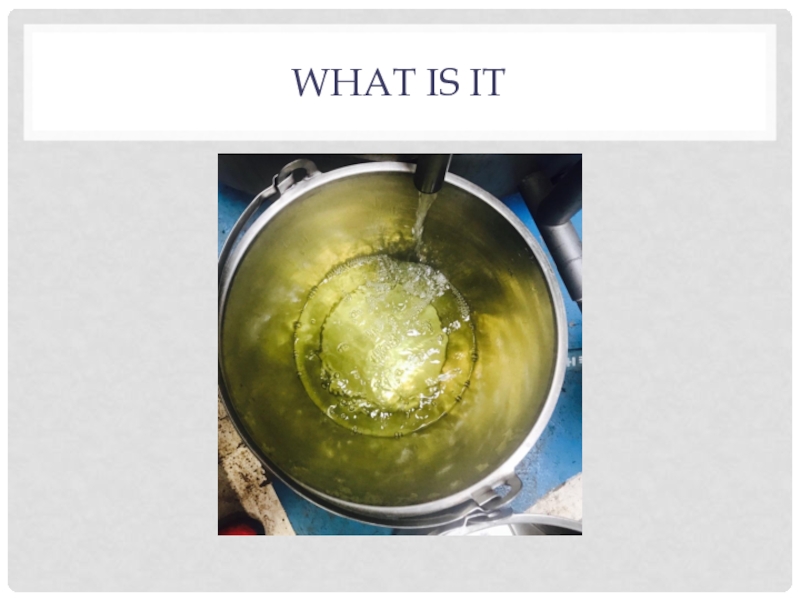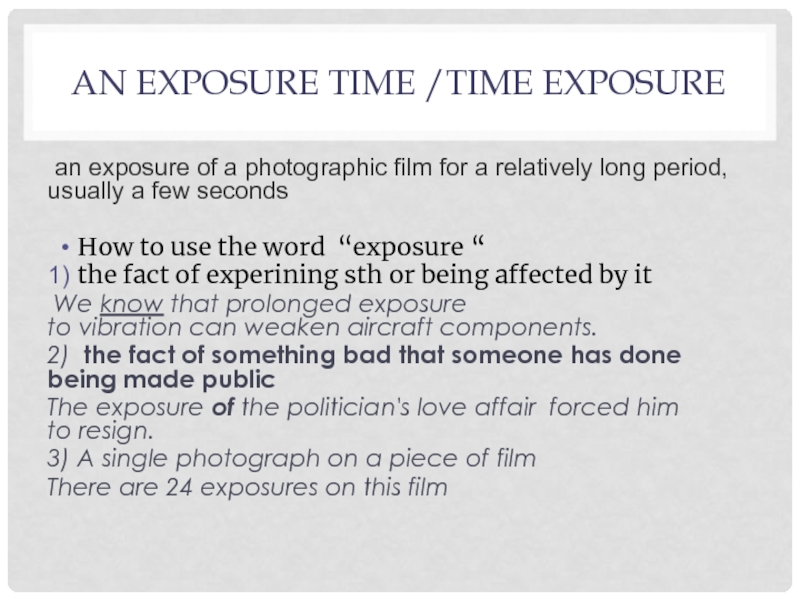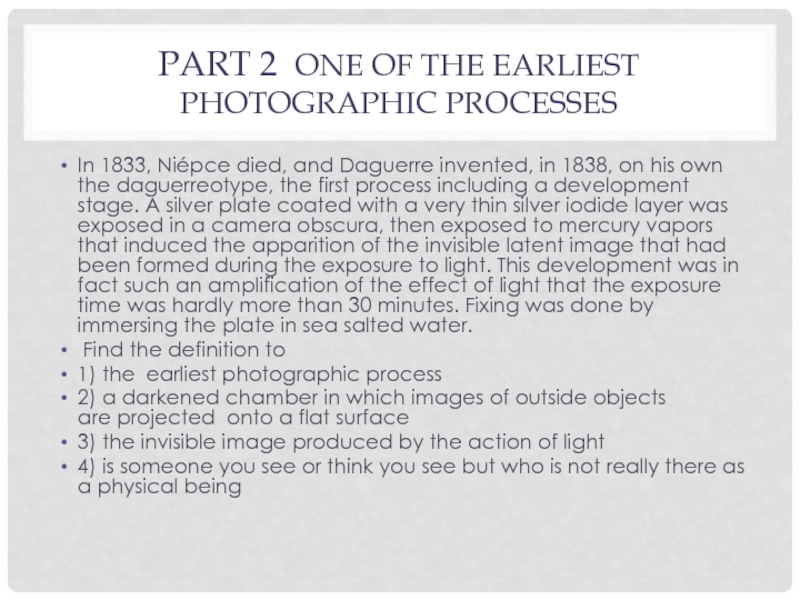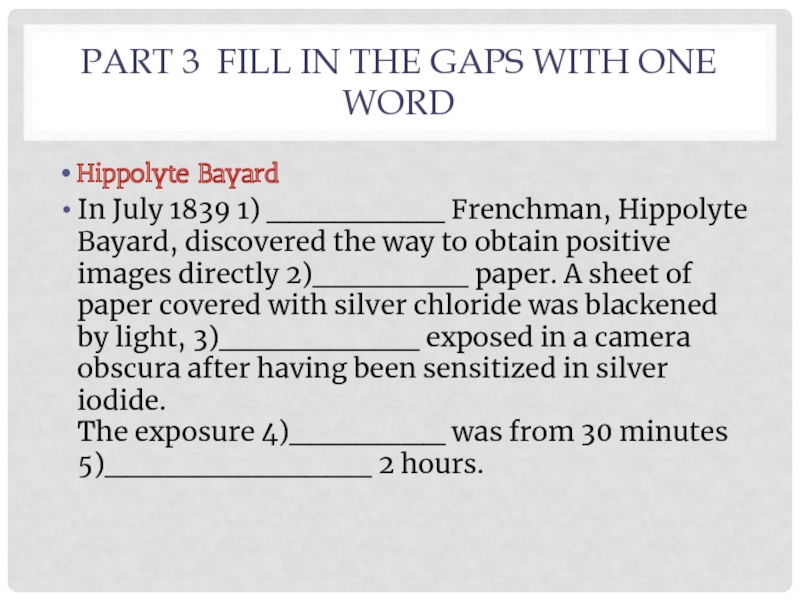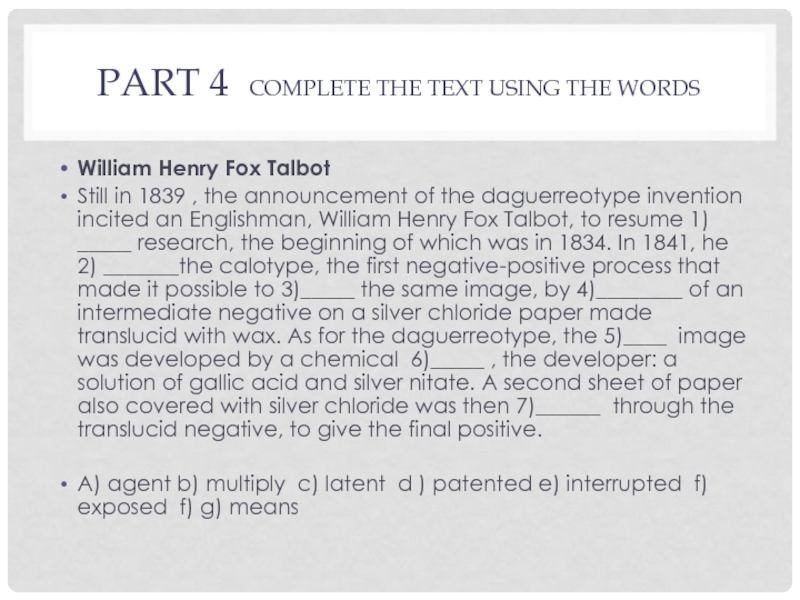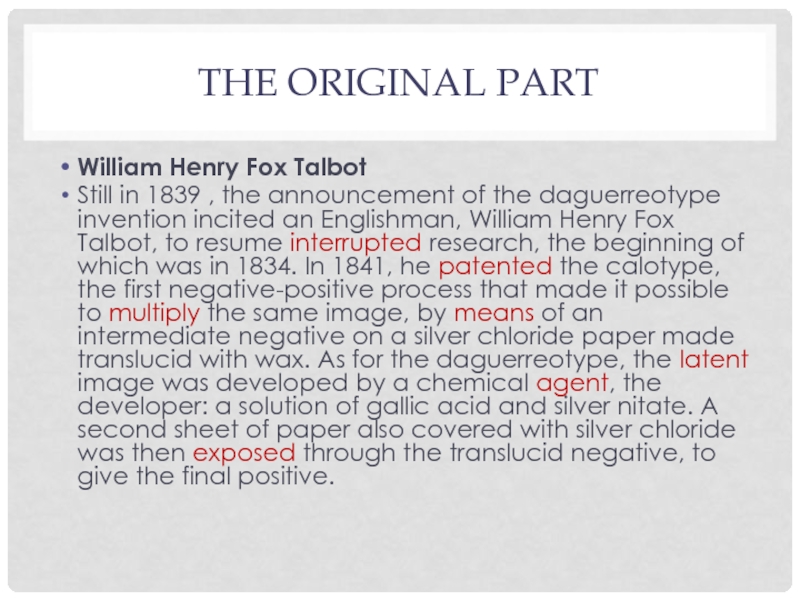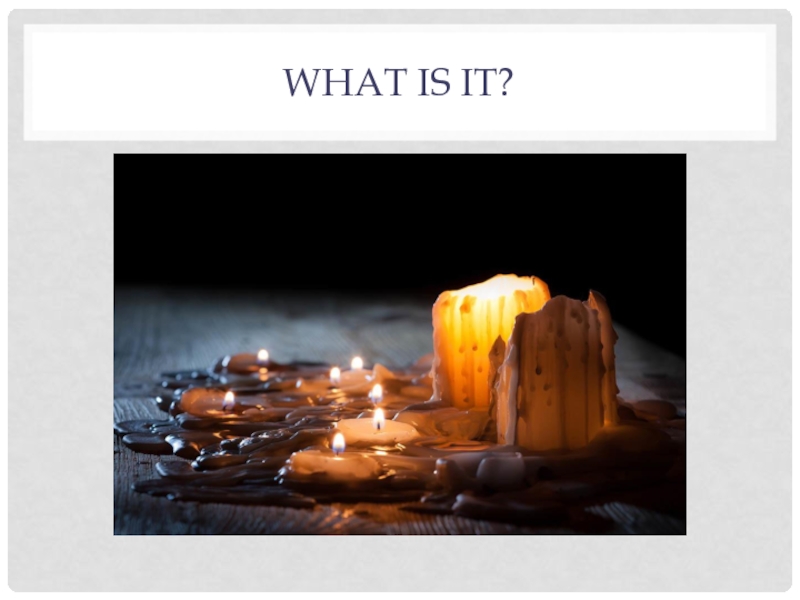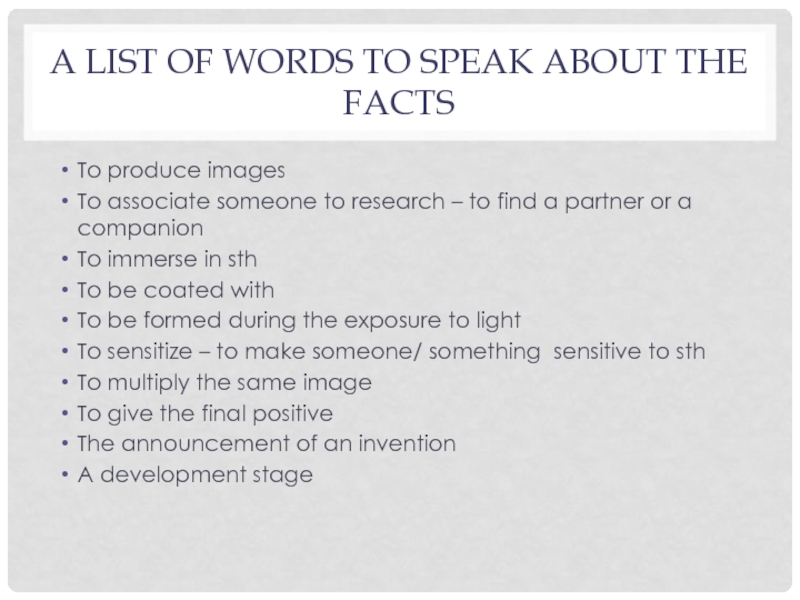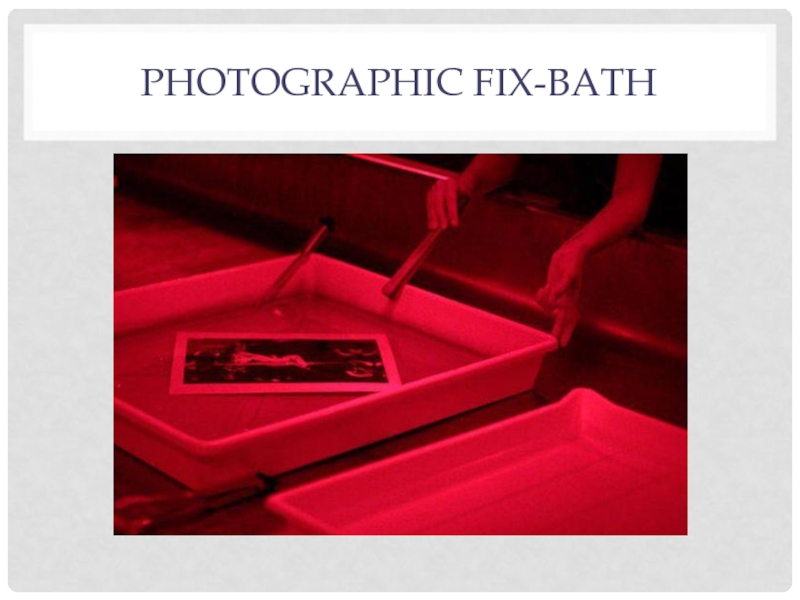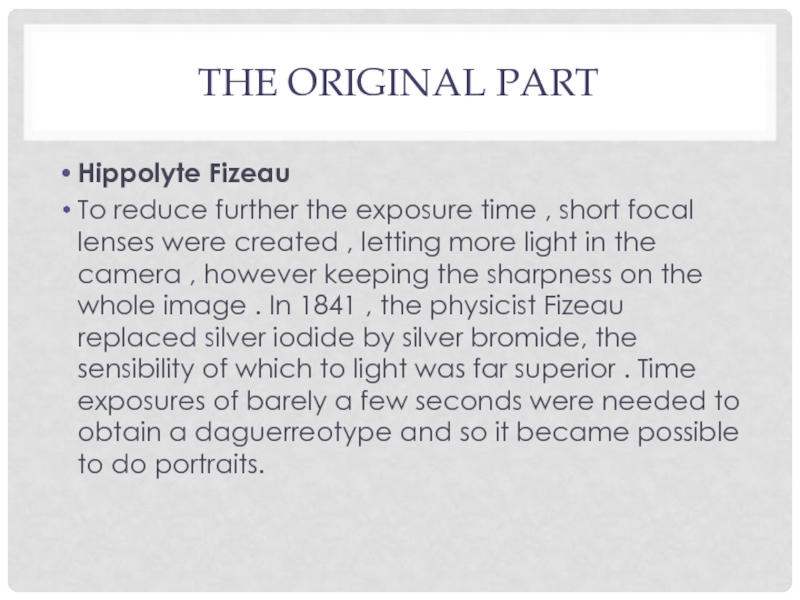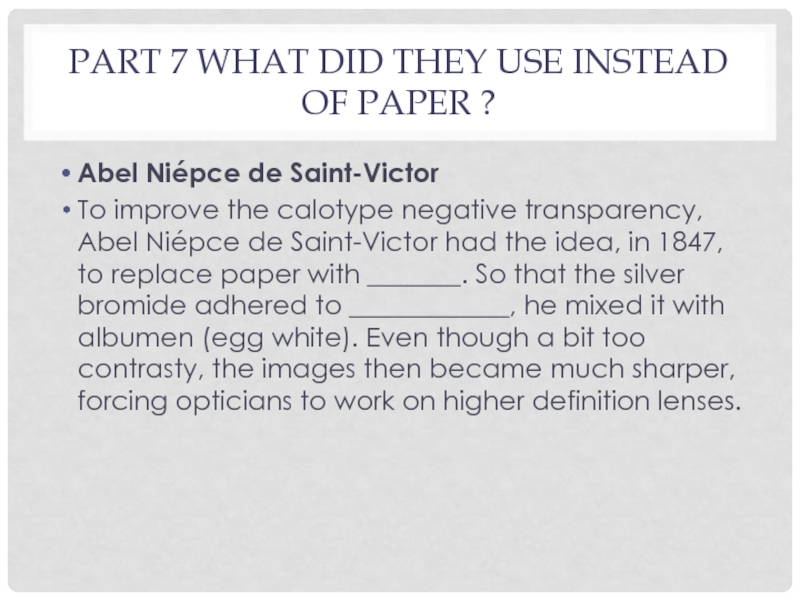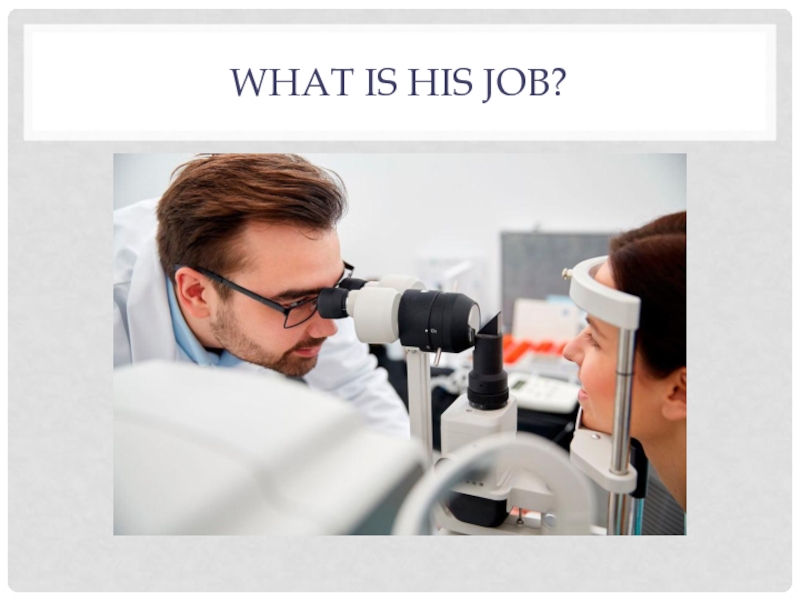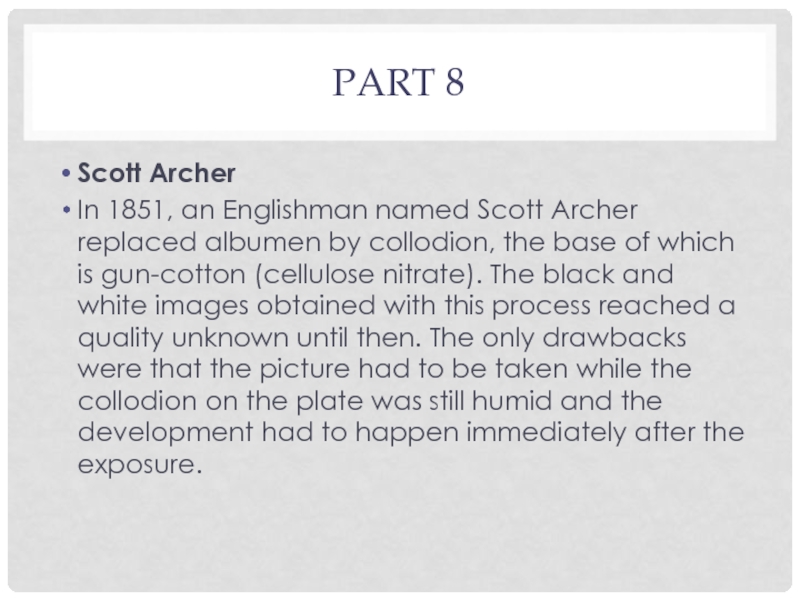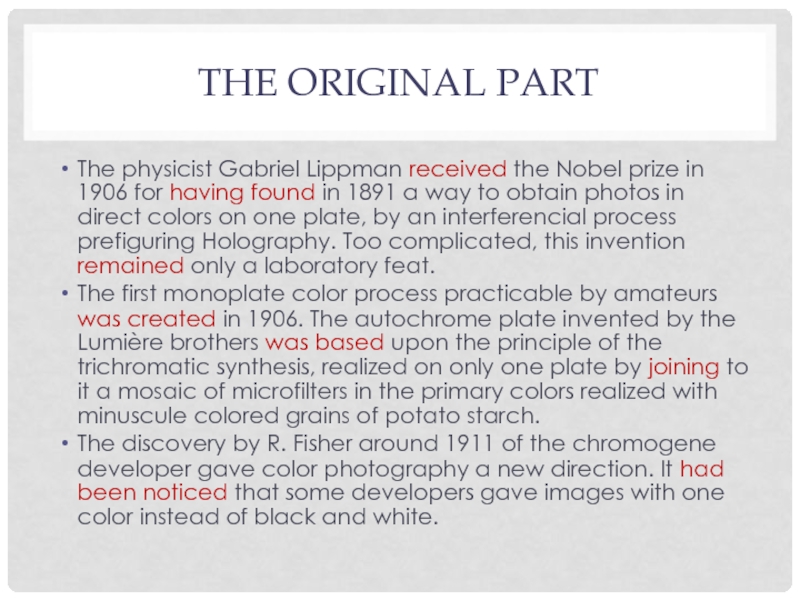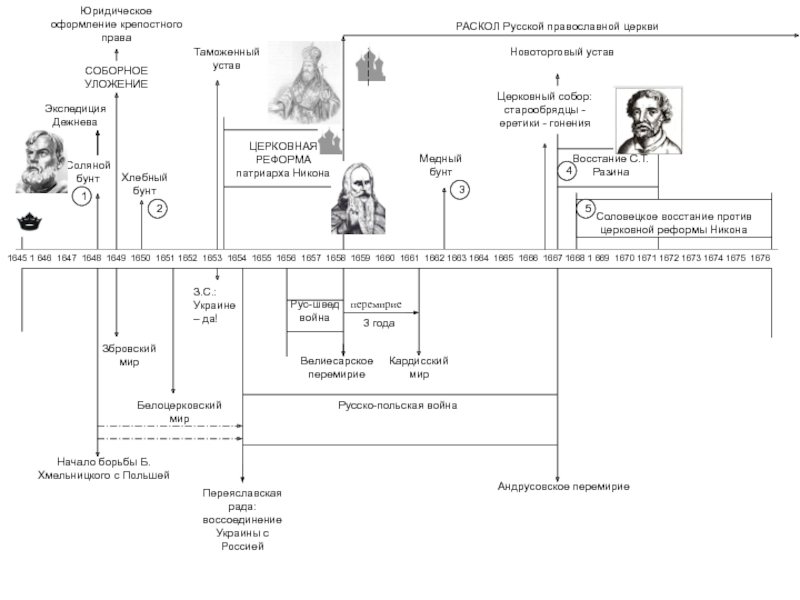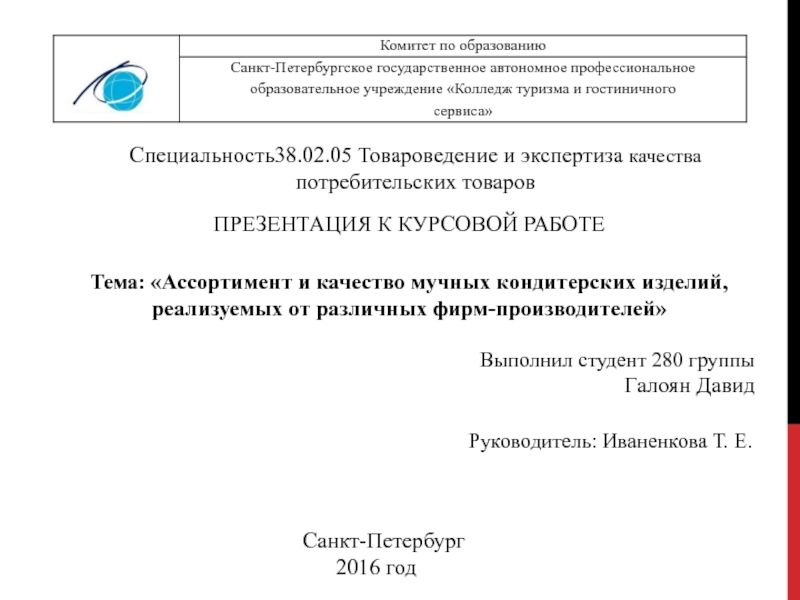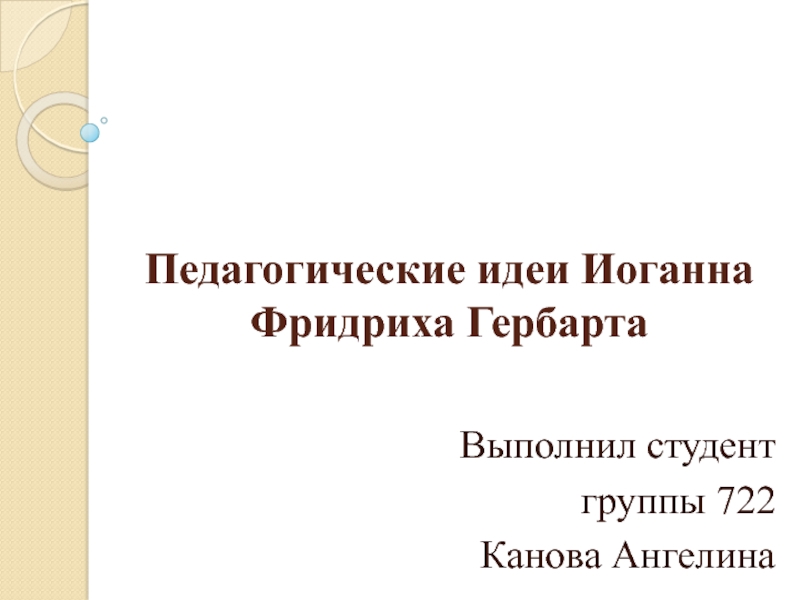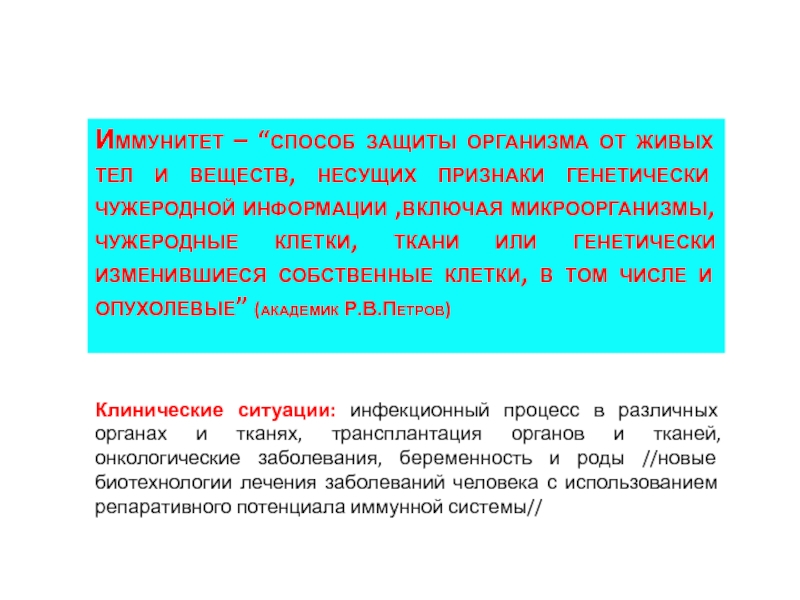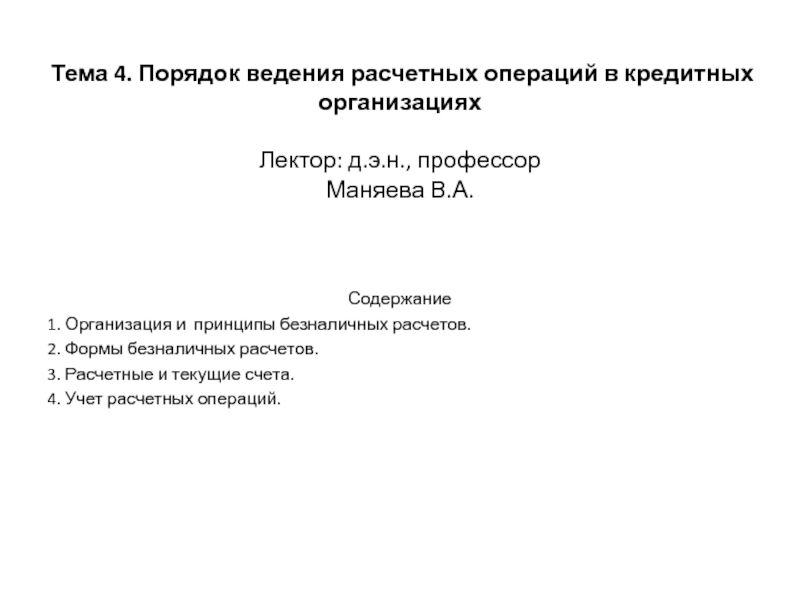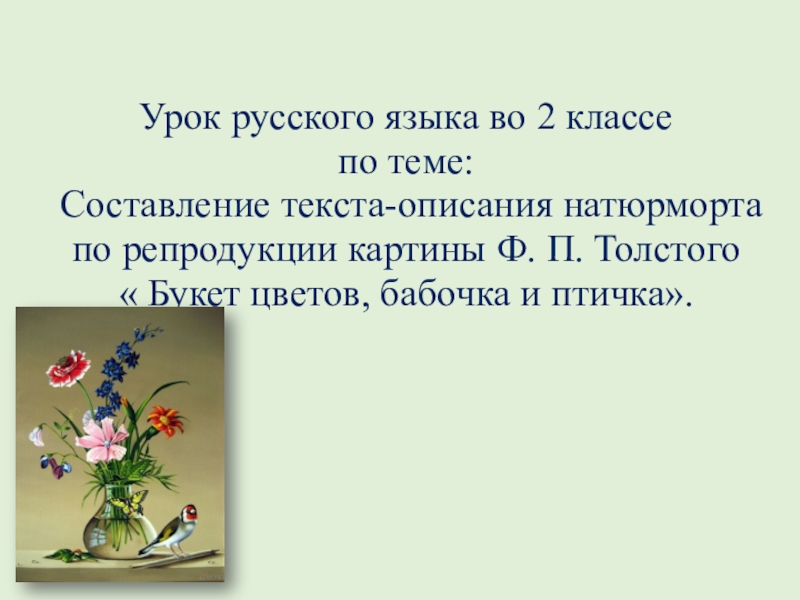Слайд 1Part 1 What is heliography?
The first photographic process — heliography
— was invented around 1824 by Nicéphore Niépce. Images were
obtained with bitumen of Judea spread on a silver plate after an exposure time of several days.
In 1829, Niépce associated Louis Jacques Mandé Daguerre to his research.
In 1832, they put the last touches, using a residue of lavender oil distillation, by means of a second process producing images in a one day exposure time.
What is a black sticky substance which is obtained from tar or petrol and is used in making roads?
An _________________ of a photographic film for a relatively long period
A _______________ of something is a small amount that remains after most of it has gone.
Слайд 3Lavender oil distillation
Why did photographers use it?
Слайд 4The answers
What is a black sticky substance which is obtained from
tar or petrol and is used in making roads? (bitumen)
An
exposure of a photographic film for a relatively long period
A residue of something is a small amount that remains after most of it has gone.
Слайд 5An exposure time /time exposure
an exposure of a photographic film for a relatively long period, usually a
few seconds
How to use the word “exposure “
the fact of experining
sth or being affected by it
We know that prolonged exposure to vibration can weaken aircraft components.
2) the fact of something bad that someone has done being made public
The exposure of the politician's love affair forced him to resign.
3) A single photograph on a piece of film
There are 24 exposures on this film
Слайд 6Part 2 One of the earliest photographic processes
In 1833,
Niépce died, and Daguerre invented, in 1838, on his own
the daguerreotype, the first process including a development stage. A silver plate coated with a very thin silver iodide layer was exposed in a camera obscura, then exposed to mercury vapors that induced the apparition of the invisible latent image that had been formed during the exposure to light. This development was in fact such an amplification of the effect of light that the exposure time was hardly more than 30 minutes. Fixing was done by immersing the plate in sea salted water.
Find the definition to
1) the earliest photographic process
2) a darkened chamber in which images of outside objects are projected onto a flat surface
3) the invisible image produced by the action of light
4) is someone you see or think you see but who is not really there as a physical being
Слайд 7The answers
daguerreotype in British (dəˈɡɛrəʊˌtaɪp )
Camera obscura
Latent image
An apparition
Слайд 9Sea salted water
Why did photographers use it?
Слайд 10Part 3 Fill in the gaps with one word
Hippolyte Bayard
In
July 1839 1) ________ Frenchman, Hippolyte Bayard, discovered the way
to obtain positive images directly 2)_______ paper. A sheet of paper covered with silver chloride was blackened by light, 3)_________ exposed in a camera obscura after having been sensitized in silver iodide.
The exposure 4)_______ was from 30 minutes 5)____________ 2 hours.
Слайд 11The original part
Hippolyte Bayard
In July 1839, another Frenchman, Hippolyte Bayard,
discovered the way to obtain positive images directly on paper.
A sheet of paper covered with silver chloride was blackened by light, then exposed in a camera obscura after having been sensitized in silver iodide.
The exposure time was from 30 minutes to 2 hours.
Слайд 12Part 4 Complete the text using the words
William Henry Fox
Talbot
Still in 1839 , the announcement of the daguerreotype invention
incited an Englishman, William Henry Fox Talbot, to resume 1) _____ research, the beginning of which was in 1834. In 1841, he 2) _______the calotype, the first negative-positive process that made it possible to 3)_____ the same image, by 4)________ of an intermediate negative on a silver chloride paper made translucid with wax. As for the daguerreotype, the 5)____ image was developed by a chemical 6)_____ , the developer: a solution of gallic acid and silver nitate. A second sheet of paper also covered with silver chloride was then 7)______ through the translucid negative, to give the final positive.
A) agent b) multiply c) latent d ) patented e) interrupted f) exposed f) g) means
Слайд 13The original part
William Henry Fox Talbot
Still in 1839 ,
the announcement of the daguerreotype invention incited an Englishman, William
Henry Fox Talbot, to resume interrupted research, the beginning of which was in 1834. In 1841, he patented the calotype, the first negative-positive process that made it possible to multiply the same image, by means of an intermediate negative on a silver chloride paper made translucid with wax. As for the daguerreotype, the latent image was developed by a chemical agent, the developer: a solution of gallic acid and silver nitate. A second sheet of paper also covered with silver chloride was then exposed through the translucid negative, to give the final positive.
Слайд 17Gallic acid
How did photographs use it?
Слайд 18A list of words to speak about the facts
To produce
images
To associate someone to research – to find a
partner or a companion
To immerse in sth
To be coated with
To be formed during the exposure to light
To sensitize – to make someone/ something sensitive to sth
To multiply the same image
To give the final positive
The announcement of an invention
A development stage
Слайд 19Part 5 How did John Herschell fix images?
John Herschell
We
owe to John Herschell the discovery, in 1839, of the
way to fix images by dipping them in a sodium hyposulfite bath, which is still used today as the main component of photographic fix-baths. The main advantages of the calotype were the easiness with which one could manipulate the paper prints and the possibility of multi-printing. On the other hand, the sharpness, limited by the fibers in the negative paper, could not compete with the daguerreotype.
Слайд 22Part 6 Focal lenses! How dis they advance the process
of photography ?
Hippolyte Fizeau
Word formation
To reduce further the 1)___________(EXPOSE)
time , short focal lenses were created , letting more light in the camera , however keeping the 2)_______________ (SHARP) on the whole image . In 1841 , the 3)___________(PHYSICS) Fizeau replaced silver iodide by silver bromide, the 4)______________ (SENSE) of which to light was far superior . Time exposures of 5)_____________ (BARE) a few seconds were needed to obtain a daguerreotype and so it became possible to do portraits.
Слайд 23The original part
Hippolyte Fizeau
To reduce further the exposure time
, short focal lenses were created , letting more light
in the camera , however keeping the sharpness on the whole image . In 1841 , the physicist Fizeau replaced silver iodide by silver bromide, the sensibility of which to light was far superior . Time exposures of barely a few seconds were needed to obtain a daguerreotype and so it became possible to do portraits.
Слайд 24Part 7 What did they use instead of paper ?
Abel Niépce de Saint-Victor
To improve the calotype negative transparency, Abel
Niépce de Saint-Victor had the idea, in 1847, to replace paper with _______. So that the silver bromide adhered to ____________, he mixed it with albumen (egg white). Even though a bit too contrasty, the images then became much sharper, forcing opticians to work on higher definition lenses.
Слайд 25The original part
Abel Niépce de Saint-Victor
To improve the calotype
negative transparency, Abel Niépce de Saint-Victor had the idea, in
1847, to replace paper with glass. So that the silver bromide adhered to glass, he mixed it with albumen (egg white). Even though a bit too contrasty, the images then became much sharper, forcing opticians to work on higher definition lenses.
Слайд 27An optician - a person who makes lenses
Слайд 28Part 8
Scott Archer
In 1851, an Englishman named Scott Archer replaced
albumen by collodion, the base of which is gun-cotton (cellulose
nitrate). The black and white images obtained with this process reached a quality unknown until then. The only drawbacks were that the picture had to be taken while the collodion on the plate was still humid and the development had to happen immediately after the exposure.
Слайд 29How did they manage to reach a quality unknown until
then?
Слайд 31Part 9 A real measuring device! What is it?
Richard
Maddox and Charles Bennet
In 1871, another Englishman, Richard Meaddox, resolved
this problem by replacing collodion by gelatin, a process perfected by Charles Bennet, who demonstrated that gelatinized plates acquired a high sensitivity when they were kept for a few days at 32° Celsius. Not only could the gelatino-bromide plates be stored before use, but their sensitivity was such that the exposure time could not exceed a fraction of a second.
The story of the shutter started shortly before 1880, because the high sensitivity of these plates made it necessary to conceive mechanisms able to let light enter the camera for 1/100th and even 1/1000th of a second.
It became necessary to precisely evaluate light intensity, and the light meter then became a real measuring device.
Слайд 33Gelatinized plates! What is special about them?
Слайд 34Part 9
The reproduction of colors
Photography was still missing color reproduction.
The first tries were due to Edmond Becquerel in 1848.
In 1851, Niépce de St-Victor showed that a silver plate coated with a layer of pure silver chloride reproduced colors directly, but in an unstable manner.
In 1869, Louis Ducos du Hauron, in Agen, made the first color photograph applying the principle demonstrated by Maxwell of light decomposition in three primary colors: red, yellow and blue. He made three photos of the same subject, each of them through a different filter: a red, a yellow, and a blue one. He obtained three positives that he dyed with the color corresponding to each filter. By superimposing in register the three images, he got the restitution of the colors.
Write down the collocations with the word COLOUR
Слайд 35Colour reproduction
To reproduce colours directly
The first colour photograph
Three primary
colours
to dye with the colour
the colour corresponding to the
filter
The restitution of the colours
To give color photography a new direction
To obtain photos in direct colours
Слайд 36Part 10 Holography
Use the verb in the correct
form
The physicist Gabriel Lippman 1)_________ (to recieve) the Nobel
prize in 1906 for 2)_____________ (to find) in 1891 a way to obtain photos in direct colors on one plate, by an interferencial process prefiguring Holography. Too complicated, this invention 3)__________ (to remain) only a laboratory feat.
The first monoplate color process practicable by amateurs 4)___________ (to create) in 1906. The autochrome plate invented by the Lumière brothers 5) _____________ (to base) upon the principle of the trichromatic synthesis, realized on only one plate by 6)____________ (to join) to it a mosaic of microfilters in the primary colors realized with minuscule colored grains of potato starch.
The discovery by R. Fisher around 1911 of the chromogene developer gave color photography a new direction. It 8) __________ (to notice ) that some developers gave images with one color instead of black and white.
Слайд 37The original part
The physicist Gabriel Lippman received the Nobel prize
in 1906 for having found in 1891 a way to
obtain photos in direct colors on one plate, by an interferencial process prefiguring Holography. Too complicated, this invention remained only a laboratory feat.
The first monoplate color process practicable by amateurs was created in 1906. The autochrome plate invented by the Lumière brothers was based upon the principle of the trichromatic synthesis, realized on only one plate by joining to it a mosaic of microfilters in the primary colors realized with minuscule colored grains of potato starch.
The discovery by R. Fisher around 1911 of the chromogene developer gave color photography a new direction. It had been noticed that some developers gave images with one color instead of black and white.

